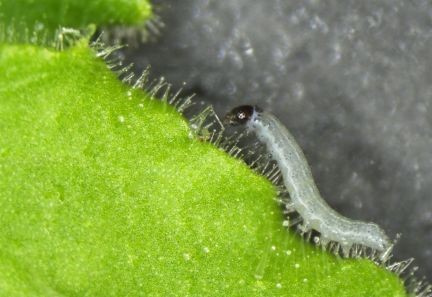FROM: James Urton
University of Washington
206-543-2580
(NOTE: researcher contact information at end)
Plants can fight back, unleashing an array of chemical defenses to discourage wayward foragers — from releasing chemicals that attract caterpillar predators to secreting compounds that make the plant taste so foul that desperate caterpillars resort to cannibalism. But scientists know little about how plants detect these attacks and marshal defenses.
In a paper published Nov. 23 in the Proceedings of the National Academy of Sciences, a team led by scientists at the University of Washington and the University of California, San Diego reports that cowpeas — a type of bean plant — harbor receptors on the surface of their cells that can detect a compound in caterpillar saliva and initiate anti-herbivore defenses.
“Despite chemical controls, crop yield losses to pests and disease generally range from 20-30% worldwide. Yet many varieties are naturally resistant or immune to specific pests,” said lead author Adam Steinbrenner, a UW assistant professor of biology. “Our findings are the first to identify an immune recognition mechanism that sounds the alarm against chewing insects.”
The receptor is a protein known by the acronym INR. The team showed that, in response to both leaf wounds and the presence of a protein fragment specific to caterpillar saliva, the cowpea’s INR protein boosts the production of ethylene, a hormone that plants often produce in response to munching by herbivores and other types of environmental stress. The protein fragment in caterpillar spit that elicited this response, Vu-IN, is actually a fragment of a cowpea protein, which gets broken down by the caterpillar as it dines on cowpea leaves.
Researchers have fewer methods to study cowpeas compared to other plants. So to learn more cellular details about INR’s function, they popped the gene for INR into tobacco plants. These tobacco plants, when exposed to Vu-IN, increased production of ethylene as well as reactive oxygen species, another anti-herbivore defense that consists of chemically reactive forms of oxygen. In addition, the team’s experiments showed that a tobacco-eating caterpillar — the beet armyworm — munched less on INR-harboring tobacco plants than plants without INR.
The research shows that plants like the cowpea sound the alarm only after their cells detect specific molecules associated with herbivory. Vu-IN is a trigger for cowpea defenses. Other plants likely have different molecular triggers for their own defensive systems, the researchers believe.
Understanding how plants activate their immune systems could help scientists develop more effective strategies to defend crop plants against hungry insects.
Co-authors are UW research scientist Antonio Chaparro; Maria Muñoz-Amatriaín of Colorado State University; Jessica Montserrat Aguilar-Venegas of the National Autonomous University of Mexico; Sassoum Lo and Timothy Close of the University of California, Riverside; Satohiro Okuda of the University of Geneva in Switzerland; Gaetan Glauser, Julien Dongiovanni and Ted Turlings of the University of Neuchâtel in Switzerland; Da Shi, Marlo Hall, Daniel Crubaugh, Ruben Abagyan, Alisa Huffaker and Eric Schmelz at UC San Diego; and Nicholas Holton and Cyril Zipfel of the University of East Anglia in the U.K. The research was funded by UC San Diego, the Life Sciences Research Fund, the University of California system, the Washington Research Foundation, the U.S. Agency for International Development, the European Research Council, the Gatsby Charitable Foundation and the U.K. Biotechnology and Biological Research Council.
###
Link to full release: https://www.washington.edu/news/2020/12/03/caterpillar-cowpea-defense/




